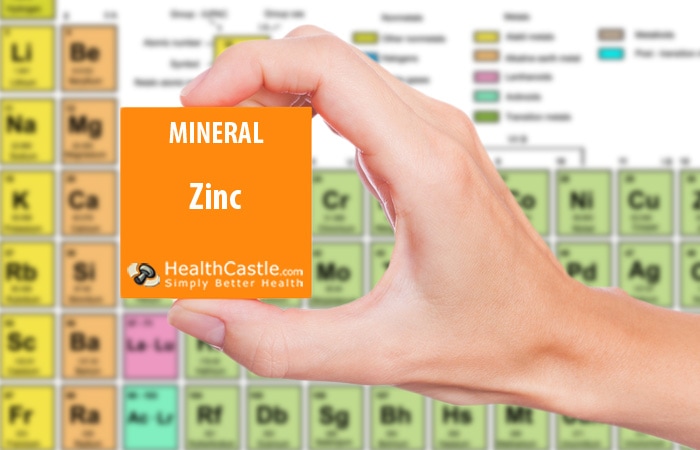
Written By: Carolyn Berry, RD
Title: Registered Dietitian
Alumni: University of British Columbia
Last Updated on:

Zinc is a mineral found in every body cell. It has been used since ancient times to help heal wounds, and it plays an important role in the immune system, reproduction, growth, taste, vision, smell, blood clotting, and proper insulin and thyroid function, to name just some of its important effects in the body.
Table of Contents
The Dietary Reference Intakes (DRI) for zinc are shown below:
| Age Group | Recommended Dietary Allowance (RDA) per Day1 | Tolerable Upper Intake Level (UL) per Day2 |
| Adults | ||
| 19 years and up | 11 mg male
8 mg female | 40 mg |
| Kids and Youth | ||
| 1 to 3 years | 3 mg | 7 mg |
| 4 to 8 years | 5 mg | 12 mg |
| 9 to 13 years | 8 mg | 23 mg |
| 14 to 18 years | 11 mg male
9 mg female | 34 mg |
| Special Considerations | ||
| Pregnant women 14 to 18 years | 12 mg | 34 mg |
| Pregnant women 19 years and up | 11 mg | 40 mg |
| Lactating women 14 to 18 years | 13 mg | 34 mg |
| Lactating women 19 years and up | 12 mg | 40 mg |

Zinc is essential for many processes in the body. It is a very important coenzyme assisting in the production of hemoglobin3, indirectly supporting the adequate transport of oxygen to our cells. It also acts as an antioxidant by helping to fight the oxidative damage caused by free radicals. It helps enzymes to generate energy from carbohydrates, fats, and protein and helps activate Vitamin A in the retina of the eye. Zinc plays a role in supporting smell and taste sensitivity, as well as promoting wound healing.
Zinc is an important regulator of many genetic activities. It plays a role in facilitating the folding of proteins into the biologically active molecules used in gene regulation. It is critical for cell replication4 and normal growth.
Zinc is essential for the proper development and functioning of the immune system5. Many types of immune cells depend on zinc for optimal function. In some studies, zinc deficiency has been shown to compromise white blood cell numbers and immune response, while zinc supplementation has been shown to restore conditions to normal.
Zinc helps to balance blood sugar by regulating the production, storage, and release of insulin6. Insulin is a hormone required to move sugar from our bloodstream into our cells. The response of our cells to insulin is called insulin response. When the foods in our diet do not provide us with enough zinc, insulin response decreases, and blood sugar remains high. Metabolic rate, the rate at which we create and use up energy, is also dependent on zinc for its regulation. When zinc is deficient in the diet, metabolic rate drops, as does the hormonal output by the thyroid gland.
Both zinc deficiency and zinc toxicity are rare in industrialized countries. Low zinc levels are sometimes seen in the elderly, alcoholics, people with anorexia, those on very restricted diets, and people with malabsorption syndromes, such as Crohn’s disease or celiac disease. Zinc toxicity can occur from consuming zinc in supplement form and in fortified foods.
The best sources of zinc are high-protein foods like seafood, meat, beans, and lentils. Some dairy products also have zinc. The highest plant-based food sources for zinc are seeds such as pumpkin seeds and sesame seeds.
| Food | Zinc per serving |
| Oyster, eastern, raw, 5 medium | 27.5 mg |
| Lamb, cooked, 3 oz | 3.8 mg |
| Sesame seeds, 1/4 cup | 3.3 mg |
| Liver (chicken), cooked, 3 oz | 3.0 mg |
| Pumpkin or squash seeds, 1/4 cup | 2.5 mg |
| Wheat germ, 1/4 cup | 2.4 mg |
| Lentils, cooked, 3/4 cup | 1.9 mg |
| Chickpeas, cooked, 3/4 cup | 1.9 mg |
| Yogurt, plain, low-fat, 3/4 cup | 1.6 mg |
| Shrimp, cooked, 3 oz | 1.4 mg |
| Veal, various cuts, cooked, 3 oz | 1.4 mg |
| Scallops, cooked, 3 oz | 1.3 mg |
| Cheese, cheddar, 1-1/2 oz | 1.3 mg |
| Wild rice, cooked, 1/2 cup | 1.2 mg |
| Beef, various cuts, cooked, 3 oz | 1.1 mg |
| Chicken, various cuts, cooked, 3 oz | 0.8-2.7 mg |
| Egg, hard-boiled | 0.5 mg |
In the United States: The % daily value gives you an idea of how much zinc is in the food you eat. The daily value for zinc is 11 mg7. The FDA does not require that the % daily value for zinc be listed on the Nutrition Facts label.
In Canada: The daily value for zinc is 11 mg8. Listing the daily value for zinc on the Nutrition Facts label is optional.
Calcium: Calcium supplementation may decrease dietary zinc absorption. This can be avoided by taking calcium supplements at bedtime instead of with meals.
Chromium: There is early evidence that chromium and zinc could each reduce the absorption of the other. However, this is likely only a problem with supplemental doses of both.
Copper: Large amounts of zinc can reduce copper absorption and can cause significant copper deficiency and anemia, a condition in which the blood cannot carry enough oxygen.
HealthCastle has strict sourcing guidelines. We reference peer-reviewed studies, scientific journals and associations. We only use quality, credible sources to ensure content accuracy and integrity.
Alumni: University of British Columbia – Carolyn Berry is a Vancouver-based Registered Dietitian, self-proclaimed foodie, marathon runner, and owner of Berry Nourished. Carolyn works in a variety of areas including clinical nutrition, outpatient counselling at Medisys Preventive Health Clinic, as a nutrition tour leader with Save-On-Foods, and in the media, including segments on CBC Television, CKNW and Spice Radio. Through informative and practical nutrition advice and her food-first approach to health, Carolyn fulfills her passion to empower others with knowledge about nutrition so that they can make the best decisions to improve their health. She strongly believes that food should be both healthful and delicious.
micronutrient - minerals, minerals, zinc